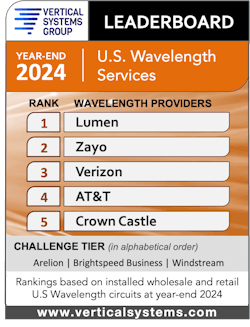Lumen remains the top contender in the optical wavelength services market, maintaining top ranking on Vertical Systems Group’s (VSG) 2024 U.S. Wavelength Services LEADERBOARD.
Driven by ongoing AI demands, Lumen intends to increase overall network capacity and attain 70% overall utilization of its network by 2028 to support various services like optical wavelengths and dark fiber.
During its fourth-quarter earnings call, Lumen said it is seeing a significant increase in demand for its network infrastructure across the hyperscaler and enterprise market segments and is expanding the network to meet that demand.
Right behind Lumen is Zayo. Through its pending acquisition of Crown Castle’s fiber solutions business and ongoing organic network builds, Zayo continues to ramp up its wavelength service capabilities.
Joining Lumen and Zayo on the 2024 U.S. Wavelength Services LEADERBOARD are Verizon, AT&T and Crown Castle. To gain a LEADERBOARD rank, a service provider must have four percent (4%) or more of the U.S. market for retail and wholesale wavelength services. Wavelength circuits are Layer 1 dedicated bidirectional gigabit-speed optical fiber connections between two sites.
Notably, the U.S. Wavelength Services LEADERBOARD companies – Lumen, Verizon, and AT&T – are also ranked on the year-end 2024 U.S. Carrier Ethernet LEADERBOARD.
Additionally, companies ranked on the 2024 U.S. Wavelength Services LEADERBOARD are major suppliers of lit fiber connectivity to commercial buildings and data centers.
Competitors step up
Competitive carriers continue to enhance their wavelength service status.
In VSG’s Challenge Tier, which includes providers with 1% and 4% share of the U.S. Wavelength market, are Arelion, Brightspeed Business and Windstream.
Windstream Wholesale continues to enhance its wavelength service reach by reaching customers directly and through partnerships with data center providers. In February, Windstream Wholesale launched a network Point of Presence (POP) and the activation of domestic U.S. wavelength services at the DC BLOX Cable Landing Station (CLS) in Myrtle Beach, S.C. This allows the provider to offer 400G wave service from the DC BLOX site through Windstream Wholesale’s long-haul Intelligent Converged Optical Network (ICON).
Likewise, Arelion has a well-established wavelength business.
Having been an early provider of 100GE wavelengths in the U.S. and in Europe, it has deployed 400GE in 80% of its U.S. network.
AI drives gig purchases
As earlier VSG’s LEADERBOARDs have shown, new AI rollouts drive gigabit wavelength service purchases.
“The U.S. installed base of Wavelength circuits grew almost eight percent in 2024 as enterprises, hyperscalers and service providers added more power and bandwidth to support soaring AI traffic,” said Rick Malone, principal of Vertical Systems Group.
One of the continuing trends in the wavelength segment is 100G and 400G speed services. The research firm noted that customer demand for 400 Gbps wavelength services is increasing, driven by hyperscalers, data center connectivity, cloud providers, and enterprises with heavy data transfer requirements.
“All major providers offer 100 Gbps waves throughout their footprints and are ramping 400 Gbps installations,” Malone said.
However, the 800 Gbps wavelength service segment has been slower to take off.
VSG said the 800G market is ramping slowly due to several challenges, including limited services and equipment availability and protracted lead times for space and power.
Despite these initial challenges, Malone said VSG “expects to see a measurable increase in 800 Gbps installations this year.”
Market shifts
Further market shifts in the wavelength services market are likely in 2025 and next year.
While Zayo continues to hold the #2 rank, the service provider’s profile will likely be enhanced when it completes its acquisition of Crown Castle’s Fiber Solutions business. Crown Castle is currently ranked #5 on the 2024 U.S. Wavelength LEADERBOARD.
However, VSG noted that Zayo’s pending acquisition “does not impact the current rankings and is expected to be completed in 2026.”
There are also going to be continued shifts in the vendor ranks.
VSG’s research showed that Ciena is the top technology supplier to Wavelength service providers in the U.S. through year-end 2024, followed by Infinera, Nokia and Cisco.
Nokia could potentially enhance its position by acquiring Infinera, which was finalized at the end of February.
For related articles, visit the Business Topic Center.
For more information on high-speed transmission systems and suppliers, visit the Lightwave Buyer’s Guide.
To stay abreast of fiber network deployments, subscribe to Lightwave’s Service Providers and Datacom/Data Center newsletters.
About the Author
Sean Buckley
Sean is responsible for establishing and executing the editorial strategy of Lightwave across its website, email newsletters, events, and other information products.



